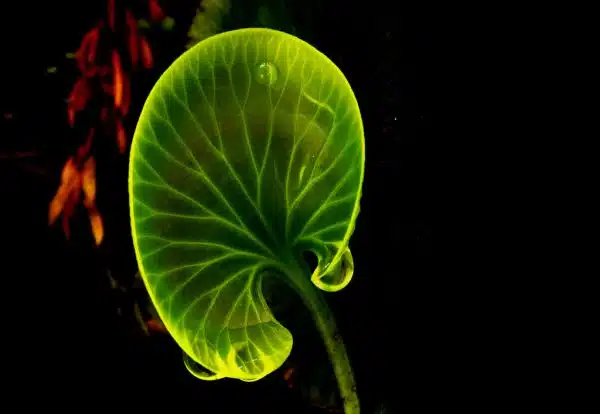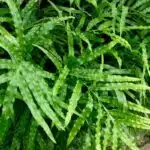Rabbit’s Foot Fern, or Davallia, is an attractive fern that has become popular among indoor gardeners. It’s a unique plant that displays furry rhizomes which resemble a rabbit’s foot. The fern is native to tropical regions such as Southeast Asia and Australia, where it thrives in humid environments. Growing and caring for Rabbit’s Foot Fern can be a rewarding experience for any plant enthusiast.
To promote healthy growth of this fern, it’s important to consider the right conditions for its survival. This includes providing adequate lighting and watering, as well as proper soil and fertilizer. Additionally, understanding the different stages of growth that the plant goes through can help ensure that it develops into a lush and vibrant specimen. Through this article, we will explore the essential steps involved in growing and caring for Rabbit’s Foot Fern so that you can enjoy its beauty in your home or office space.
Getting To Know The Rabbit’s Foot Fern
Rabbit’s foot fern, also known as Davallia fejeensis, is a popular houseplant that originates from Fiji. It gets its name from the furry rhizomes that grow on top of the soil, resembling a rabbit’s paw. Apart from being attractive, this fern has several benefits that make it a must-have in any indoor garden.
One of the most significant advantages of owning a rabbit’s foot fern is its air-purifying properties. As with many other ferns, it can help improve indoor air quality by removing harmful toxins such as formaldehyde and benzene. Additionally, this plant is relatively low maintenance and does not require special attention to thrive.
There are several varieties of rabbit’s foot fern available in the market, with different leaf shapes and sizes. The most common type features long fronds that can grow up to two feet in length. Other variations include the dwarf rabbit’s foot fern, which stays relatively small, making it ideal for small spaces. When selecting your plant, consider factors like light requirements and humidity levels to ensure you pick the right variety for your home environment. With these benefits and variations in mind let us now dive into how to care for rabbit’s foot ferns starting with choosing the right pot and soil.
Choosing The Right Pot And Soil
When selecting a pot for a rabbit’s foot (davallia) fern, a pot size of 6 to 8 inches is recommended for optimal growth. The soil type should be a potting mix that is slightly acidic and well-draining. Proper drainage is essential for a healthy plant, so ensure the pot has at least one drainage hole. Fertilizing, moisture, light, and temperature requirements should be followed to ensure the rabbit’s foot fern is properly cared for.
Pot Size
When it comes to choosing the right pot size for your rabbit’s foot fern, it is important to consider a variety of factors. First and foremost, you want to make sure that the pot is large enough to accommodate the plant’s root system. A pot that is too small can restrict growth and lead to root damage, which can ultimately harm the health of your fern.
Another benefit of repotting your rabbit’s foot fern into a larger pot is that it allows for better drainage. When water is able to flow freely through the soil and out of the bottom of the pot, it helps prevent issues such as root rot and fungal infections. Additionally, a larger pot provides more space for organic matter, which can help nourish your plant and promote healthy growth.
When selecting a new pot for your rabbit’s foot fern, aim for one that is approximately 1-2 inches wider than its current container. This will give the roots plenty of room to grow without overwhelming them with too much space. Remember to choose a high-quality soil mix as well, as this will provide essential nutrients and help maintain proper moisture levels. With careful attention to detail and proper care techniques, your rabbit’s foot fern will thrive in its new home!
Soil Type
When choosing the right pot and soil for your rabbit’s foot fern, it is crucial to consider several factors. One of which is the type of soil that best suits the plant’s needs. The ideal soil mixture for rabbit’s foot fern is well-draining, rich in nutrients, and has excellent moisture retention properties. The best compost to use is organic matter such as peat moss, coco coir, or sphagnum moss.
The proper soil mix can help promote healthy growth and prevent common problems such as root rot or fungal infections. It should have a good balance of structure and porosity to allow water to flow through it quickly while also retaining enough moisture to keep the roots hydrated. It is also essential to ensure that there is adequate pot drainage so that excess water can escape easily.
When repotting your rabbit’s foot fern, make sure to choose a high-quality soil mix that meets these criteria. Mix the compost with perlite or coarse sand before adding it to the pot to increase aeration and improve drainage. Remember not to compact the soil too tightly around the roots as this can impede their growth. With proper care techniques and attention to detail, your rabbit’s foot fern will thrive in its new home!
Optimal Lighting For Your Fern
After choosing the right pot and soil for your rabbit’s foot fern, it is important to consider the optimal lighting conditions for its growth. These plants thrive in bright but indirect light, making them ideal for placement near windows or under fluorescent lights. However, direct sunlight can cause damage to the leaves and roots, leading to sunburn and stunted growth.
To prevent sunburn, adjust the lighting as needed by moving the plant away from direct sunlight or using a sheer curtain to filter out excess light. It is also important to maintain consistent lighting conditions, avoiding sudden changes that can shock the plant. If you notice signs of sunburn such as brown spots on the leaves or wilting foliage, move the plant to a shadier spot immediately.
Proper lighting is crucial for healthy growth of your rabbit’s foot fern. By adjusting light levels and preventing sunburn, you can ensure that your plant thrives in its environment. In the next section, we will discuss how to water your fern properly to keep it healthy and happy.
Watering Your Rabbit’s Foot Fern
- Rabbit’s Foot Ferns (Davallia) require regular watering, as they are native to tropical climates, and are best kept moist.
- An ideal soil mix for this species should be composed of two parts peat moss, one part perlite, and one part coarse sand.
- The frequency of watering will depend on the climate, but in general should occur about once a week, or when the top inch of soil has dried out.
- It is important to ensure that the soil does not become totally dry or saturated, as this can cause the plant to become stressed or die.
- To prevent overwatering, drainage should be provided at the bottom of the pot, as well as allowing the pot to sit in a tray of water to allow the soil to absorb moisture from the bottom up.
- Additionally, it is recommended to water Rabbit’s Foot Ferns with distilled water or rainwater, as regular tap water may contain excessive minerals that can damage the plant.
Watering Frequency
One of the most crucial aspects of caring for a Rabbit’s Foot Fern is maintaining a proper watering schedule. Over-watering can be detrimental to the fern’s health as it may lead to root rot and other fungal diseases. Thus, it is essential to keep the soil moist but not waterlogged.
The ideal watering schedule for a Rabbit’s Foot Fern is once a week or when the top inch of soil feels dry. During summer or warmer months, you may need to water more frequently due to increased evaporation. Conversely, in colder months, you can reduce the frequency of watering.
Preventing over-watering is possible by ensuring adequate drainage in your pot. You can use well-draining potting soil mixed with perlite or sand that allows excess water to drain out quickly. Additionally, avoid leaving your plant sitting in standing water as it may cause waterlogging and lead to root rot. By following these watering tips, you can help your Rabbit’s Foot Fern thrive and grow into an attractive houseplant.
Soil Requirements
When it comes to caring for a Rabbit’s Foot Fern, watering is just one of the many aspects that need attention. Another crucial factor that affects the plant’s growth and health is the type of soil used. The soil requirements for a Rabbit’s Foot Fern are unique and need to be carefully considered to ensure optimal growth.
One essential aspect of soil quality that needs attention is its pH level. The ideal pH range for a Rabbit’s Foot Fern lies between 5.5 to 6.5, which indicates an acidic to slightly acidic soil composition. Maintaining the right pH balance is critical as it affects how well the plant can absorb nutrients from the soil. If the pH level falls outside this range, it can lead to nutrient deficiencies or toxicities, impacting the plant’s overall health.
Testing soil quality is an essential step in ensuring you have the right conditions for your Rabbit’s Foot Fern. Even if you use high-quality potting mix, it may not always meet your plant’s specific requirements. You can test your soil by using a home testing kit or sending samples to a lab for analysis. Based on the results, you can make adjustments such as adding amendments like peat moss or fertilizers to correct any imbalances and provide optimal growing conditions for your fern.
Overwatering Prevention
As plant care experts, we understand the importance of watering your Rabbit’s Foot Fern accurately. However, overwatering is a common mistake that can harm your fern and impede its growth. Preventing overwatering is crucial to ensure your plant thrives and remains healthy.
One of the telltale signs of overwatering is yellowing leaves. The root system becomes waterlogged, and the excess moisture prevents the roots from absorbing oxygen, leading to yellow leaves, stunted growth or even death. Other signs of overwatering include wilting, moldy soil or brown spots on leaves.
To prevent overwatering, it’s essential to allow the top inch of soil to dry out before watering again. This can be achieved by checking the soil moisture level regularly. Another effective method is to use a well-draining potting mix that allows excess water to drain away from the roots quickly.
In summary, preventing overwatering is crucial for ensuring optimal growth and health for your Rabbit’s Foot Fern. By watching for signs of overwatering and implementing proper watering techniques such as allowing the soil to dry out and using well-draining potting mix, you can help your fern thrive and flourish.
Fertilizing Your Fern
Fertilizing Your Fern:
Fertilizing your rabbit’s foot fern is crucial to ensure that it remains healthy and vibrant. Using organic fertilizer is highly recommended as it provides essential nutrients that the plant needs without risking any harm to the environment or the fern itself. You can use either liquid or granular slow-release fertilizers, depending on your preference.
Frequency of fertilization is also an important factor to consider. As a general rule, it’s best to fertilize your fern during its growing season, which typically occurs in spring and summer. During this time, you should fertilize every two weeks with a diluted solution of organic fertilizer. However, be careful not to over-fertilize as this can lead to salt buildup in the soil and damage the roots of your fern.
Maintaining a healthy and well-fed rabbit’s foot fern will greatly depend on consistent and proper fertilization practices. Regular use of organic fertilizer during its growing season can help promote growth and provide necessary nutrients for optimal health. In order to avoid any potential issues with over-fertilization, always follow instructions carefully and monitor your plant’s response to ensure it is thriving under appropriate care. The next step in caring for your rabbit’s foot fern involves managing humidity levels.
Managing Humidity Levels
- Rabbit’s foot fern (Davallia) requires a high level of humidity to thrive; humidifiers and mist spraying are both effective methods for increasing humidity levels.
- Humidifiers can be used to increase the relative humidity in a room; they are best used in combination with other methods, such as misting.
- Mist spraying is a simple and effective way to increase humidity levels; it should be done in the morning so the water evaporates quickly and does not encourage fungal or bacterial growth.
- Air flow is also important for the health of a Rabbit’s foot fern; circulating air will help reduce the risk of fungal or bacterial growth and reduce the risk of leaf scorch.
- Open windows or fans can be used to create air flow, but these should be used cautiously; too much air flow will result in dry air and could damage the leaves.
- The best way to maintain the necessary humidity levels for a Rabbit’s foot fern is to use a combination of humidifiers, mist spraying, and air flow; this will ensure the plant is provided with an environment that is not too dry or too damp.
Humidifiers
As a horticulturist, proper humidity management is crucial in plant care. One way to ensure the ideal humidity level for plants is by using a humidifier. A humidifier works by emitting water vapor into the air, increasing the moisture content of the surrounding environment. This is especially beneficial for plants that require high levels of humidity, such as the rabbit’s foot fern (davallia).
Using a humidifier has numerous benefits for plant growth. It supports optimal photosynthesis and transpiration rates in plants, which ultimately leads to better overall health and growth. Additionally, it helps prevent dryness on foliage and soil, which can cause stress and damage to plants. For rabbit’s foot ferns specifically, maintaining high humidity levels can help prevent leaf browning or tip dieback.
When using a humidifier for plant care, it’s important to choose the right type of humidifier and follow manufacturer instructions carefully. Over-humidification can lead to problems such as mold growth or root rot, so it’s essential to monitor humidity levels regularly with a hygrometer or similar tool. By incorporating a humidifier into your plant care routine, you can provide your rabbit’s foot fern with optimal growing conditions and enjoy its lush green foliage for years to come.
Mist Spraying
Proper humidity management is essential in plant care, and one effective way to achieve this is by misting the plants. Mist spraying involves using a fine spray of water to increase the moisture content in the surrounding environment, which can be beneficial for plants that require high levels of humidity, such as ferns. The benefits of misting extend beyond just increasing humidity levels.
One of the significant benefits of misting is that it helps prevent pests and diseases from infesting the plants. Regular misting can help keep spider mites, mealybugs, and other insects at bay. Additionally, it can reduce the risk of fungal diseases that can develop due to dry foliage or soil conditions. However, it’s important not to overdo it with misting as excessive moisture on leaves or soil can lead to issues such as mold growth or root rot.
The frequency of misting depends on various factors such as plant species, temperature, and humidity levels. As a general rule of thumb, ferns like rabbit’s foot ferns should be misted at least once per day during dry seasons or when indoor heating systems are running. It’s best to use room temperature water and avoid getting water on flowers or blooms as this can cause them to rot. With proper mist spraying techniques and frequency, you can help your plants thrive in optimal growing conditions.
Air Flow
Proper humidity management is crucial in plant care, and mist spraying is one effective way to achieve this. While misting can help increase moisture levels around the plants, it’s also essential to consider air flow as a factor in managing humidity levels. Good air circulation can help prevent stagnation and improve overall plant health.
Improving air flow is beneficial for plants as it helps prevent the buildup of moisture on leaves or soil, which can lead to fungal diseases or rotting. Air movement also helps disperse excess heat and carbon dioxide, which can accumulate around the plants if there’s insufficient ventilation. Without proper air flow, plants may struggle to absorb nutrients efficiently and grow optimally.
Preventing stagnation through proper air flow requires strategic placement of plants and the use of fans or open windows to create a gentle breeze. Avoid placing plants too close together, which can restrict airflow and cause them to compete for resources. Regularly cleaning dust or debris from leaves and soil surfaces also helps improve air circulation. By paying attention to both misting frequency and air flow, you can create an environment that promotes healthy plant growth.
Pruning And Maintenance
Maintaining a healthy growth for your rabbit’s foot fern is crucial to its longevity. Proper pruning techniques and seasonal maintenance should be followed to ensure that the fern remains healthy and vibrant year-round.
Pruning techniques for the rabbit’s foot fern are straightforward. Regularly removing any yellow or dead fronds will prevent the plant from expending unnecessary energy on dying foliage. Additionally, trimming back long stems or branches can help maintain the plant’s shape and prevent it from becoming too leggy. Pruning should be done with clean, sharp scissors or shears to avoid damaging the plant.
Seasonal maintenance is also important for the rabbit’s foot fern. During the growing season, which typically lasts from spring through fall, regular watering and fertilization should be provided to encourage healthy growth. In contrast, during the dormant season (winter), watering should be reduced, and fertilization can be stopped altogether until spring arrives.
In caring for your rabbit’s foot fern, proper pruning techniques and seasonal maintenance are essential components of ensuring its health and vitality. By following these guidelines, you’ll help your fern thrive year-round. In the next section, we’ll discuss how to propagate your fern to keep it growing strong for years to come.
Propagating Your Fern
As a horticulturist, I understand the satisfaction of growing and propagating plants. Propagating your Rabbit’s Foot fern (Davallia) can be a rewarding experience for any plant enthusiast. There are several propagation techniques that you can use to expand your collection of ferns. These include spores, division, and offsets.
Propagation by spores is an interesting technique that requires more patience than other methods. This process involves collecting spores from mature fronds and sowing them in a suitable growth medium such as sphagnum moss or peat moss. The time frame for propagation using spores is usually longer than other methods, ranging from 6-12 months until the ferns reach maturity.
Division and offsets are quicker methods that involve separating the root mass of the parent plant into smaller sections. This method allows you to produce multiple new plants in one go. To propagate using this technique, carefully remove the parent plant from its container and divide it into smaller sections with roots attached. Plant each divided section in its own pot with fresh soil mix.
In conclusion, propagating your Rabbit’s Foot fern (Davallia) can be achieved through various techniques such as spores, division, and offsets. The time frame for propagation varies depending on the method used; spore propagation takes longer compared to division and offsets which produce faster results. Now that you have successfully propagated your ferns, it’s important to know how to deal with pests and diseases to ensure their long-term survival.
Dealing With Pests And Diseases
Prevention is the best approach when it comes to dealing with pests and diseases in rabbit’s foot ferns. Start by ensuring that the plant is healthy and growing in optimal conditions. This includes providing adequate light, moisture, and ventilation. Additionally, avoid over-fertilizing or over-watering the plant as this can make it more susceptible to pests and diseases.
One of the most common pests that affect rabbit’s foot ferns is spider mites. These tiny insects thrive in dry conditions and can cause significant damage to the plant if left unchecked. Prevention methods include misting the plant regularly to increase humidity levels and removing any infested leaves or stems immediately. Natural remedies like neem oil or insecticidal soap can also be effective in controlling spider mites.
When it comes to diseases, root rot is a common problem that affects rabbit’s foot ferns. This fungal infection thrives in moist soil conditions and can cause the plant to wilt or die. Prevention methods include using well-draining soil, avoiding over-watering, and ensuring good air circulation around the roots. If root rot does occur, natural remedies like cinnamon powder or hydrogen peroxide can be used to control the fungus.
Moving on from prevention methods for pests and diseases, there are some common problems that you may encounter when caring for your rabbit’s foot fern. In the next section, we will discuss these issues in detail and provide solutions for each one so that you can keep your fern healthy and thriving.
Common Problems And Solutions
When growing and caring for rabbit’s foot fern, it is important to be aware of common pests that can cause damage. Some of the most common pests that affect this plant include spider mites, mealybugs, and scale insects. Identifying these pests early on is crucial in preventing them from causing too much damage to your plant. Inspect your fern regularly and look for signs of infestations such as webbing or sticky residue.
Preventing root rot is another important aspect of caring for rabbit’s foot fern. Overwatering and poor drainage can lead to root rot which can quickly kill your plant. It is important to ensure that the soil is well-draining and that you only water your fern when the top inch of soil feels dry to the touch. If you notice any signs of root rot such as wilting or yellowing leaves, it may be necessary to repot your plant in fresh soil and cut away any damaged roots.
Despite our best efforts, sometimes yellowing leaves can occur on our rabbit’s foot ferns. This can be a sign of several issues including over or underwatering, lack of nutrients, pest infestation, or even environmental stressors such as temperature fluctuations or low humidity levels. Troubleshooting yellowing leaves requires careful observation and identification of potential causes. By addressing the underlying issue and adjusting your care routine accordingly, you can help restore your plant’s health and vitality.
Troubleshooting Yellowing Leaves
- When it comes to watering, rabbit’s foot (davallia) ferns require a high level of moisture, and should be watered regularly to avoid yellowing leaves.
- Proper light exposure is also important for these plants, as too much or too little light can cause yellowing.
- The ideal light for these plants is bright, indirect sunlight, as direct sunlight can cause burning and yellowing of the leaves.
- Fertilizer can also be helpful in promoting health and vigor in the plant, but should be used sparingly to avoid over-fertilization and yellowing.
Watering
Watering is an essential aspect of caring for rabbit’s foot fern. As a horticulturist or plant care expert, one must be careful not to overwater the plant, as it can cause root rot and yellowing leaves. To prevent overwatering, ensure that the pot has proper drainage holes and avoid watering the plant excessively. The frequency of watering should be based on the moisture level of the soil.
Signs of underwatering may include dryness and wilting of leaves, and in severe cases, leaf drop. If this happens, it’s important to water the fern thoroughly, ensuring that water reaches deep into the soil. It’s advisable to use lukewarm water as cold water may shock the delicate roots of the fern.
To keep your rabbit’s foot fern healthy and thriving, it’s crucial to maintain a consistent watering schedule. Water only when you notice that the top inch of soil is dry to touch. Additionally, ensure that excess water drains out of the pot promptly after watering to prevent stagnant water from accumulating in the pot. With appropriate watering practices in place, you can enjoy a lush green rabbit’s foot fern in your indoor garden for years to come.
Light Exposure
Yellowing leaves are a common issue that many plant owners face, including those who care for rabbit’s foot ferns. While overwatering is one of the most common reasons for yellowing leaves, there are other factors to consider, including light exposure. As a horticulturist or plant care expert, it’s important to understand the impact of natural and artificial light on your rabbit’s foot fern.
Rabbit’s foot ferns prefer bright but indirect light. They thrive in areas with filtered sunlight, such as shaded areas or rooms with east-facing windows. However, direct sunlight can be harmful and lead to leaf burn or yellowing leaves. Artificial light can also be used to supplement natural lighting for rabbit’s foot ferns kept indoors. When using artificial lighting, ensure that it provides the same intensity and spectrum as natural light.
When choosing a location for your rabbit’s foot fern, consider the direction of natural light exposure in your indoor garden. East-facing windows offer optimal morning sun exposure without harsh afternoon rays that can damage the fern. West-facing windows provide strong afternoon sunlight but may require additional shading during peak hours to avoid leaf burn or yellowing leaves. With proper light exposure, your rabbit’s foot fern can thrive and display its beautiful green foliage for years to come.
Repotting Your Rabbit’s Foot Fern
Although rabbit’s foot ferns are known to thrive in small containers, it is still necessary to repot them from time to time. The repotting process should be done once every two years or when the plant shows signs of being root-bound. This means that the roots have outgrown their container and are starting to curl around themselves, which can lead to poor growth and stunted development.
When choosing a suitable container size for your fern, make sure it is only slightly larger than the current one. This will prevent over-potting and ensure that the plant has enough room to grow without being overwhelmed by too much soil. Before placing the fern into its new container, add a layer of well-draining potting mix at the bottom to aid in water drainage.
To determine if your rabbit’s foot fern needs repotting, look for signs such as yellowing leaves or stunted growth. If you notice any of these indicators, it may be time for a new container. However, be careful not to overdo it as too much soil can lead to waterlogged roots and other issues. By following these steps, you can keep your rabbit’s foot fern happy and healthy for years to come.
As you continue caring for your rabbit’s foot fern, you may consider growing it outdoors. This is a great way to give your plant more space and light exposure while also adding some greenery to your outdoor landscape. In the next section, we will discuss how to grow rabbit’s foot ferns outside and what conditions are needed for optimal growth.
Growing Your Fern Outdoors
Outdoor placement is a great option for rabbit’s foot ferns. They thrive in partially shaded areas and can also tolerate full shade. However, it’s important to consider the climate of your region before placing them outdoors. These ferns are sensitive to cold temperatures and frost, so they should be brought indoors or protected during the winter months.
Seasonal care is essential for the healthy growth of your ferns. During the summer months, ensure that they receive enough water and keep the soil consistently moist but not waterlogged. In contrast, during the winter months, reduce watering to prevent root rot. It’s also important to note that rabbit’s foot ferns need high humidity levels, which can be achieved by misting them frequently or placing a humidifier nearby.
When growing your rabbit’s foot fern outdoors, consider pairing it with other plants that share similar care requirements. For example, combining it with hostas or heucheras can create a beautiful and low-maintenance shade garden. Additionally, adding some flowering plants such as impatiens or begonias can add a pop of color and visual interest to your outdoor space. Overall, taking proper care of your rabbit’s foot fern will ensure its longevity and beauty in any outdoor setting.
Combining With Other Plants
Pairing suggestions for the rabbit’s foot fern (Davallia) are abundant, as this unique plant can add texture and interest to any arrangement. One popular choice is to pair it with other ferns or tropical plants, such as the Boston fern or bird’s nest fern. These plants complement each other well due to their similar growing conditions and foliage. Another option is to contrast the soft, furry fronds of the rabbit’s foot fern with spiky succulents, such as aloe vera or echeveria. This pairing adds visual interest and highlights the unique characteristics of both plants.
Design possibilities with the rabbit’s foot fern are endless, as its versatile growth pattern allows for various arrangements. A common design technique is to place it in a hanging basket or vertical garden, allowing its lush fronds to cascade down and create a dramatic effect. Alternatively, placing it on a windowsill or tabletop paired with other plants can create a cohesive look that brings life into any room. Additionally, incorporating decorative elements such as rocks or wood chips around its base can enhance its natural appearance and add depth to the overall arrangement.
Enjoying your beautiful rabbit’s foot fern requires minimal maintenance and provides endless opportunities for creativity in pairing and design. Whether you choose to pair it with other tropical plants or use it as a stand-alone statement piece in your space, this unique plant is sure to bring life into any environment. So go ahead, experiment with different designs and pairings – your rabbit’s foot fern will thrive in any arrangement!
Enjoying Your Beautiful Rabbit’s Foot Fern
A flourishing rabbit’s foot fern is a beautiful addition to any home. As with any plant, the key to enjoying its beauty lies in proper care and maintenance. With some patience and attention to detail, you can keep your fern healthy and thriving for years to come.
To showcase the beauty of your rabbit’s foot fern, consider creating a DIY planter that compliments the decor of your home. A simple wooden planter or hanging basket can add a touch of natural elegance to any room. When selecting a planter, make sure it has adequate drainage holes as this type of fern prefers moist soil but does not tolerate standing water. Additionally, avoid placing your fern near drafty windows or vents as it prefers stable temperatures and humidity levels.
Finally, displaying your fern in different rooms can create unique ambiance throughout your home. This versatile plant can thrive in low light conditions making it ideal for bathrooms or bedrooms without much natural light. Alternatively, if placed near a bright window it will develop lush green fronds that cascade over the edges of the planter adding life to living spaces like living rooms or dining areas. By following these tips, you’ll be able to enjoy the beauty of your rabbit’s foot fern while adding warmth and vitality to any part of your home.
| Location | Lighting | Temperature |
|---|---|---|
| Bathroom | Low Light | Warm |
| Bedroom | Low Light | Cool |
| Living Room | Bright Light | Warm |
Frequently Asked Questions
Can Rabbit’s Foot Ferns Be Grown In Water?
Water cultivation has become a popular method for growing various plants, including rabbit’s foot ferns. One advantage of water cultivation is that it eliminates the risk of overwatering or underwatering, which can be detrimental to the plant’s growth. Additionally, water cultivation provides a cleaner environment for the fern as it reduces the chances of soil-borne diseases and pests. However, there are also disadvantages to water cultivation. It requires more frequent monitoring and maintenance as water needs to be changed regularly to prevent the growth of algae and bacteria. Moreover, soil contains essential nutrients that are necessary for plant growth, which may not be present in water alone. Therefore, while water cultivation may work well for some plants, it is important to consider their individual requirements before deciding on this method over traditional soil cultivation.
How Often Should I Mist My Rabbit’s Foot Fern?
The best watering practices for rabbit’s foot ferns involve keeping the soil consistently moist, but not waterlogged. It is recommended to water your fern when the top inch of soil feels dry to the touch. Avoid letting the soil dry out completely, as this can cause damage to the plant’s delicate roots. In addition to regular watering, misting your rabbit’s foot fern can also help maintain its humidity requirements. The ideal humidity range for this plant is between 50-60%. Misting once or twice a week with room temperature water can help provide additional moisture and prevent leaf tips from drying out. Overall, consistent and appropriate watering practices are essential for maintaining healthy growth and appearance of your rabbit’s foot fern.
Can Rabbit’s Foot Ferns Survive In Low-Light Conditions?
Can the Rabbit’s Foot Fern survive in low-light conditions? The answer is yes, as this fern has a high adaptability to low light. However, it is important to note that while it can withstand low light, it will not thrive without adequate light sources. Artificial lighting options such as fluorescent or LED lights can provide the necessary light for growth if natural sunlight is not available. It is recommended to place the fern near a north-facing window or in a room with bright indirect light if possible. With proper care and attention, the Rabbit’s Foot Fern can flourish even in less than ideal lighting conditions. As a horticulturist or plant care expert, ensuring the survival and well-being of plants is our top priority, and we strive to provide knowledge and guidance for those who share this passion for serving nature.
Can I Propagate My Rabbit’s Foot Fern By Division?
Propagating ferns through division is a common technique used by horticulturists and plant care experts. The process involves separating the parent plant into smaller sections, each with its own set of roots and foliage. This is typically done when the parent plant has grown too large for its container or when it begins to show signs of decline. When propagating rabbit’s foot (Davallia) ferns using division, it is important to carefully separate the sections and ensure that each new piece has an adequate amount of roots and foliage to support its growth. Additionally, it is recommended to use a well-draining soil mix and provide ample water and indirect light during the propagation process. With proper care, propagated rabbit’s foot ferns can thrive just as well as their parent plants.
What Are Some Natural Remedies For Treating Pests On Rabbit’s Foot Ferns?
Natural remedies for treating pests on ferns are a great alternative to synthetic pesticides, especially when dealing with sensitive plants such as the rabbit’s foot fern. Some effective natural treatments include neem oil, insecticidal soap, and garlic spray. These remedies work by suffocating or repelling pests without harming the plant or its environment. Additionally, DIY fern fertilizers can be made using organic materials such as coffee grounds and eggshells to provide essential nutrients that promote healthy growth. When dealing with pest infestations or nutrient deficiencies, it is important to identify the problem early on and take swift action to prevent further damage. By incorporating these natural remedies and fertilizers into your regular plant care routine, you can ensure the continued health and vitality of your rabbit’s foot fern.
Conclusion
Rabbit’s foot ferns, also known as Davallia fejeensis, can be a lovely addition to any indoor garden. These ferns grow best in well-draining soil and require moderate watering. While they can handle low-light conditions, they benefit from occasional bright light exposure. Additionally, they can be propagated by division.
One common question regarding rabbit’s foot ferns is whether they can be grown in water. While it is possible, it is not recommended as the roots may rot if left submerged for too long. It is also important to mist your fern regularly to keep its foliage healthy and hydrated.
If you notice pests on your rabbit’s foot fern, there are natural remedies you can use such as neem oil or insecticidal soap. However, prevention is key – make sure to keep your plant clean and remove any dead or diseased foliage promptly.
In conclusion, growing and caring for a rabbit’s foot fern requires attention to detail and patience. With proper care, these plants can thrive and add a touch of natural beauty to any space. Remember that just like the rabbit’s foot symbolizes good luck, taking care of your plant will bring about positive energy and growth in your life.
Image Credits
- “Kidney Fern New Zealand.” by Bernard Spragg (featured)





























